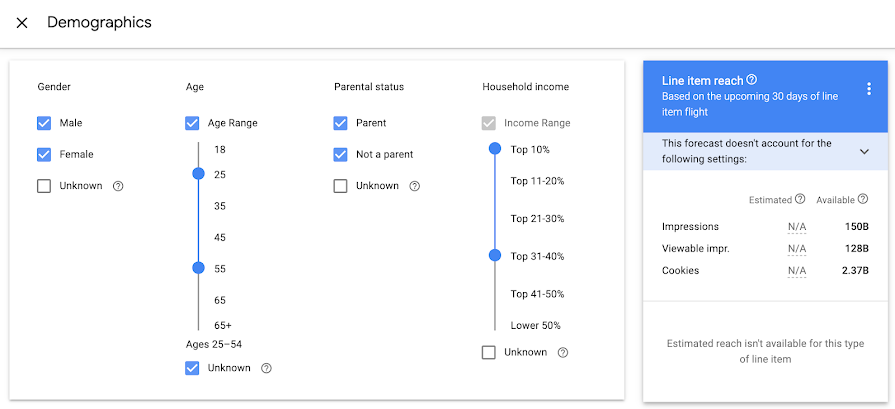Google Ads offers an incredible 8:1 return on investment. For every $1 you spend advertising on the platform, you can expect an average $8 in return.
In part, we can thank Google’s sophisticated audience targeting options for that ROI. Audience targeting is key to running a successful Google Ads campaign.
The platform provides advanced segmentation features that allow you to hone in on highly specific audience groups, including demographic, interest, and behavior targeting. Each of these audience targeting options can dramatically improve your ad performance. Let’s take a look.
Sections
1. Demographic targeting
Demographic targeting is core to any advertising strategy, allowing marketers to focus on specific groups based on criteria such as age, gender, household income, and parental status. But Google Ads takes demographic targeting a step further, as you can layer these options for even more granular segmentation.
For example, a parenting product can be marketed more effectively by focusing on users who are parents, specifically those in the 25-34 age range. If you offer a luxury parenting product, you can additionally choose to target users within the top 10% of household incomes.

Google also allows for bid adjustments on different demographic segments, meaning you can allocate more budget to higher-value groups or restrict your ad visibility to those segments that align best with your objectives.
Plus, you can exclude certain demographic groups that may not be relevant to your campaign. This helps reduce wasted ad spend by allowing you to focus solely on the potential customers who are the best fit for your product or service.
2. Interest-based targeting
Google Ads also offers interest-based targeting, also known as affinity and custom affinity audiences. Affinity audiences are predefined groups of users who have shown interest in certain topics based on their browsing behavior, search history, and the websites they visit.
For example, if you’re advertising a travel-related product, you can target users who have demonstrated an interest in travel, booking vacations, or visiting specific destinations. Google provides a broad range of predefined affinity audiences, such as “Travel Buffs,” “Beauty Mavens,” or “Tech Enthusiasts.”
In addition to predefined categories, custom affinity audiences allow you to create more personalized audience groups by adding specific interests, URLs, or keywords. This targeting option gives you the flexibility to define exactly who your ideal audience is based on their online behavior, making your targeting even more precise.
For example, if you’re launching a new video game, you can create a custom affinity audience targeting users who have recently searched for terms like “best video games of 2024” or visited gaming blogs and forums.
3. Behavior-based targeting
Behavior targeting, including in-market and life event audiences, allows marketers to reach users based on their recent actions and purchasing intent. In-market audiences focus on users actively searching for products or services similar to yours, indicating that they are in the decision-making process. These users are closer to making a purchase, which makes in-market targeting highly valuable for conversion-focused campaigns.
For example, if you’re selling auto insurance, Google Ads lets you target users in the “Auto Insurance” in-market audience—in other words, people who are actively researching and comparing policies.
Life event targeting, on the other hand, focuses on users undergoing significant milestones, such as getting married, moving homes, or having a baby. These users are often in need of specific products or services related to their life event, and targeting them can result in highly relevant ads—leading to more clicks and conversions.
For example, wedding planners can target users who are preparing for marriage, while home improvement companies might focus on people who have recently moved.
Combining audience targeting strategies for more success
Here’s the best part about audience targeting in Google Ads: you can actually combine various targeting methods for even better ad performance. That’s right. You can create complex audience segments by layering demographic, interest, and behavior-based targeting. This hybrid approach allows for greater precision and minimizes wasted spend by ensuring your ads reach the people most likely to engage with you and your products or services.
For example, you might target young parents in the top 20% of household incomes who are also actively researching travel destinations. This layered approach ensures your ad dollars are spent on the most valuable potential customers.
Whether you’re trying to reach new customers or re-engage with those already familiar with your brand, mastering audience segmentation is key to unlocking the full potential of Google Ads. For more tips on how to optimize audience targeting in Google Ads, contact Your Marketing People today.







